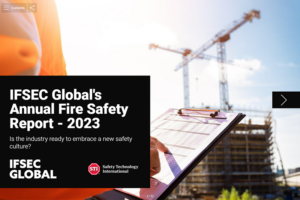Often located on large, remote sites, energy and power utilities are particularly vulnerable to attack. Damage or destruction of these critical facilities has the potential to not only severely disrupt daily life, but also threaten public health and even cause loss of life.
Not only must these utilities safeguard assets, but they must also comply with exacting government standards, particularly for CPNI-classified locations. With a range of power facilities encompassing power stations, multiple substations and the distribution network, and often operating in harsh environments and hazardous areas, there needs to be clear focus on mitigating proposed security risks and breaches, improving situational awareness and managing critical incidents.
For utilities involved in nuclear power, both international recommendations and national regulations apply and are responsible for implementing the security guidelines of the International Atomic Energy Agency (IAEA) as enacted under the UK’s Nuclear Industries Security Regulations 2003.
The UK Government Counter-Terrorist Response Levels system is adopted throughout the UK civil nuclear industry to ensure consistent baseline security measures are applied and that necessary incremental measures are implemented in response to a change in the terror threat.
System design
Compliance with, and implementation of, applicable legal requirements in health and safety, quality management and environmental protection are paramount in the energy utility environment. All projects must be risk-assessed at feasibility and design stage, with specific health, safety and environmental risk registers developed and maintained throughout the project lifecycle.
Risk assessments and method statements should identify individual tasks and detail necessary controls to eliminate or minimise potential hazards.
A whole lifecycle approach to system design is essential to deliver maximum safety, resilience, longevity and reliability. In particular, the adoption of industry standard devices and software platforms with common IT integration methods is essential to ensure the integration of both analogue and digital technologies and devices.
A key requirement is to automate routine security and fire safety tasks. Staff can concentrate on core business activities while protecting facilities and the distribution network with high performance risk-management systems based on the latest safety and security technologies.
A typical project scope should encompass:
Information and intelligence
Siemens’ approach is to implement layers of security and safety, starting at the perimeter to enable full control of the site, as well as monitor sensitive and hazardous areas.
At the core of the system is an advanced software management platform that will integrate CCTV, video analytics, electric fencing, card access, fire protection, emergency evacuation and other multiple devices to deliver a single point for site-wide command and control.
Integrated wide-area surveillance, automatic number plate recognition cameras, video analytics, robust perimeter alarms and intruder protection systems will confirm any unusual or suspicious activity and have a varying identification profile to address differing conditions, creating an intelligent electronic ring fence around the site.
Effective site control is established by card access at key locations to monitor personnel activity and restrict unauthorised entry.
Access control starts at the site entry points, controlling gates, barriers and road blockers with secure pedestrian access via turnstiles. This then enables accurate information for an evacuation roll call.
Time zones and access zones can be configured to reflect site and operational conditions and biometrics can be implemented on high security areas to further verify the identity of individuals.
Energy and power facilities are particularly vulnerable as they extend over vast areas and can encompass a number of remote locations. It’s not only difficult and expensive to safeguard large perimeters and fence lines, but the requirement for costly duct networks, together with associated power supplies and cabling infrastructure, places significant demands on available resources.
Further cost efficiencies can be achieved by the adoption of solar-powered perimeter devices that utilise light, not just the sun, as their energy source and will remain powered for up to three months.
Advanced fire safety
For high level fire protection, fire safety systems should surpass the requirements of EN54 with superior detection, offering the earliest possible warning of fire. Detectors need to evaluate each situation minute by minute and take decisions on complex criteria, eliminating the potential for unwanted alarms and offering 100% reliability in critical locations where immediate and accurate fire detection is vital to life safety and business continuity.
For sensitive and particularly demanding environments requiring an extremely high level of protection, and where immediate and accurate fire detection is vital to life safety, the adoption of aspirating smoke detection (ASD) will provide greater alarm certainty and false alarm immunity.
Unlike conventional smoke detection, ASD actively draws smoke to the detector through boreholes within a piping system that runs throughout the protected area. This offers a significantly higher level of protection as standard systems can only respond if smoke can actually reach the detection element, which can be too late in critical environments.
Emergency evacuation
Working in tandem with high level fire detection are voice alarm systems that enable both automatic and live messaging to alert all personnel to any fire incident. These assist in the phased, orderly and safe evacuation from multi-level, multi-occupancy buildings and should be fully integrated into the fire safety solution to provide high level protection.
Research has proven that in an emergency, people will react without confusion or panic if they receive a clear, intelligible message.
In many instances people hear the warning bell or sounders, but they are unsure if it is a real emergency and unclear about what action to take. They may even continue with their activities and ignore the alert.
This can lead to significant delays in ensuring the area is evacuated. Voice alarm systems ensure that people are informed via the spoken word, either live or pre-recorded, about what is happening and what action to take. Clear messaging assists in evacuating all personnel safely, quickly and efficiently as they are aware of the nature of the emergency.
It is vital that life-critical systems are fully supported by engineering teams who are trained to identify and interpret customer specifications, CDM requirements, relevant legislation and British standards, and the impact on health, safety and the environment. High level security and fire safety solutions save lives and protect organisations and reputations. Furthermore, they ensure business continuity across the UK’s vital services.
2023 Fire Safety eBook – Grab your free copy!
Download the Fire Safety in 2023 eBook, keeping you up to date with the biggest news and prosecution stories from around the industry. Chapters include important updates such as the Fire Safety (England) Regulations 2022 and an overview of the new British Standard for the digital management of fire safety information.
Plus, we explore the growing risks of lithium-ion battery fires and hear from experts in disability evacuation and social housing.


